UMD rink-rats rise to NCAA final
By John Gilbert
Most college hockey players who leave early to sign professional contracts don’t go directly to the NHL, and leave frustrated coaches behind while serving minor league apprenticeships somewhere such as the American Hockey League (AHL). At Minnesota-Duluth, where the Bulldogs will try for their first-ever NCAA championship Saturday night, the AHL is greatly responsible for the team’s success — but it’s a different AHL.
“It’s the Afternoon Hockey League,” said Bulldog coach Scott Sandelin, whose team takes on Michigan at 6 p.m. Saturday in the Frozen Four final at Saint Paul’s Xcel Energy Center.
UMD (25-10-6) is in its fourth NCAA Frozen Four, and has only reached the championship game one other time, in 1984, where the Bulldogs suffered an excruciating 5-4 loss in four overtimes to Bowling Green. Michigan (29-10-4) is chasing its 10th NCAA crown. But the last Wolverine titles came in 1998, and 1996, so none of the current Wolverines has any memory of them. But this group is working on its own platform.
Michigan won the CCHA season title by a point on the final day of the season, then was upset 5-2 by Western Michigan in the CCHA playoffs. Since the NCAA started, the Wolverines have embarked on what looks like a mission to knock off all the WCHA teams it can find in NCAA tournament play. The Wolverines beat Nebraska-Omaha 3-2 in overtime and Colorado College 2-1 to win the West Regional, then stunned North Dakota 2-0 with an empty-net clincher in Thursday’s Frozen Four semifinals. UMD, which beat Notre Dame 4-3 in the first semifinal, is the fourth straight WCHA team to try to prevent the Wolverines from raising their record supply of NCAA trophies.
To win its first NCAA title, UMD will have to rely on its “Gold” line, the unit with Jack Connolly centering Mike Connolly and Justin Fontaine. It is that unit that supplies the weaponry for UMD’s slick power play, which has carried the Bulldogs to an NCAA tournament run that shows East Regional victories of 2-0 over Union and 5-3 over Yale, before squeaking past Notre Dame 4-3. The Bulldog power play got both goals against Union, three of the five against Yale, and three of the four against Notre Dame. That means 8 of the 11 goals UMD has scored in the NCAA tournament so far have come with the man-advantage, and their 8-of-23 efficiency is 34.8 percent since the NCAAs began.
The outburst also has boosted the “Gold” linemates closer to the top of WCHA all-game scoring. North Dakota’s Matt Frattin leads with 36-24–60, but he was shut out against Michigan. Jack Connolly, who got a goal against Notre Dame, is now 18-41–59, Fontaine, who had 3 assists against the Irish, is 22-36–58, and Mike Connolly, who had a goal against the Irish, is 28-26–54.
“One thing we didn’t plan on against North Dakota was to take so many penalties, against that power play,” said Michigan coach Red Berenson. “And now we play Duluth, which has an even better power play.”
There are several reasons for the line’s great success. One is that they are familiar with each other and seem to think on the same wave-length, and all three are quick to share the puck as much as shoot it. The fact that they seem smoother and quicker than ever since the tournament started has nothing to do with extra practice, Sandelin said. But it might have a lot to do with UMD’s own version of the AHL.
“Nothing much that they do can surprise me now, because I’ve seen them so much,” said Sandelin. “I worry that when you see them every day, you might not appreciate them as much, but our power play is effective because we have different options, and the players we have on the power play like to create from within the group.
When it was suggested that the way they interact is less by design than it is improvisation, much like pond-hockey, or just being rink-rats, Sandelin quickly agreed.
“That’s basically what it is — rink-rat hockey, and the AHL. After practice every day, we have the AHL. We get our assistant coaches out there to play against our top players. Derek Plante, Brett Larson and Bill Watson are just like kids, just like the players. I used to go out there with them, and with , too. When we first added Derek, Billy’s first line was ‘Good, now our AHL team will have someone else who can get me the puck.’ ”
Watson was a Hobey Baker winner as a star winger on the UMD league championship teams of 1984 and ’85. Plante played later, and was a stickhandling and puck-moving wizard at center who went on to play in the NHL. Larson was a smart, quick defenseman, as was Sandelin. So when they go out as a penalty-killing unit, with Larson and Sandelin on defense, and Plante and Watson up front, it is formidible opposition. The free-spirited rink-rat game has carried over to the Frozen Four, and followed the team’s final practice of the season Friday at Xcel Center.
“Today we had Watson, Larson and Plante against the Gold line,” said Sandelin. “The Gold line won. They had lost to them the last time, so they owed them one.”
Another key to their success is that they’re in UMD’s own AHL, instead of possibly the American Hockey League. Because the unrelated Connollys are both 5-foot-8 juniors, and Fontaine a 5-foot-10 senior, none of the three has been pursued by the pros, the way they might be if they were less skilled but 6-foot-2. In fact, all three remain undrafted, and will be free to pursue free-agent deals with any NHL team. “It’s true,” said Sandelin. “If Mike Connolly, or Jack Connolly, were 6-feet, they wouldn’t be juniors at UMD.”
Their presence is required for such a strong power play, but it also requires two more ingredients for the five-man unit. One of the others is freshman defenseman Justin Faulk, who has been brilliant as a puck-mover or shooter from center-point on the blue line. In recent weeks, Sandelin moved freshman winger J.T. Brown onto that power-play unit, shifting Fontaine back to play the other point. Fontaine, who is called “Fonzie” throughout the team, moves up to the left circle while Faulk mans center-point, and as the Connollys maneuver around, either cycling the puck to each other in the right corner to get free in the right circle, or one of them moving to the slot, Brown works the end boards and and is dangerous passing or shooting for back-door plays.
Against Notre Dame, Brown scored from the left circle after a pass in by Faulk for the first UMD goal, and when it was 2-2, Faulk fed in from center point to Fontaine at the left circle, and he quickly relayed one of his trademark Fonzie passes, which is precisely placed in shooting position — this time to Mike Connolly in the slot for a goal. In the second period, the unit passed with dizzying precision until Fontaine circled out near the blue line, then passed deep on the left to Brown, who passed quickly through a defenseman’s legs and past goaltender Mike Johnson to the right circle, where Jack Connolly one-timed his shot so quickly that the ESPN cameras couldn’t catch him. The puck was in the net before Jack came into focus.
As for the match up with Michigan’s big, aggressive and creative team, it is comparatively unique. In all the years of having Division I hockey, UMD has played the Wolverines only one time. That was in 2001, at the Maverick Stampede. “I remember it,” said Sandelin, who was in his novice coaching time back then. “We went down to Omaha for the Stampede and beat Nebraska-Omaha the first night, then we beat Michigan 3-2. When I called home, my wife was more excited than I was. ‘You beat MICHIGAN?’ she said.”
After upsetting North Dakota Thursday night, Berenson stressed that North Dakota was the best team. “No way we match up,” he said. “But the best team doesn’t always win.”
Friday, Sandelin smiled and said, “Red’s been around a long time. He knows what to say. They did what they had to do to win against North Dakota. And so did we against Notre Dame. I think they can play better, and hopefully, we can too. It should be a great game.”
Sky is the limit in new Camaro convertible
By John Gilbert
From the good ol’ high-performance days of the 1960s and ’70s, tradition has it that there are Chevy folks and there are Ford folks, and the twain isn’t likely to meet. It may be retro tradition, which would be appropriate, because the hottest history of the Chevy vs. Ford rivalry has been resurrected, 40 years later with the reborn Chevrolet Camaro taking on the never-left Ford Mustang.
The Mustang enjoyed a rejuvenation when the most recent styling changes took on the decided retro look of the 1970 model. Chevrolet spent a few years promoting that the discontinued Camaro would return, and when it finally came out, it was an enormous success. For the 2010 model year, Camaros outsold all versions of the Mustang, a fact that Chevrolet isn’t at all shy about trumpeting.
For 2011, the Camaro adds a model by going topless. A convertible model promises to cause another spike in sales for this year, and you can check the right boxes and wind up with a very impressive Chevrolet Camaro V6, or go all the way to the SS — Super Sport — convertible with a Corvette LS3 V8 and 426 horsepower.
Granted, there are others cars in the “ponycar” class besides the Mustang and Camaro. Dodge, for example, and Japanese, Korean, and German sports coupes and hot sedans fill the picture of contemporary performance cars. But none of that can detract from the new Camaro’s eye-popping success. When the Mustang first went retro, driving one on the street meant waves, horn honks and thumbs-up gestures from fellow-drivers and passengers, whether Ford, Chevy or anything else. The same happens with the new Camaro, and certainly with the Camaro convertible. Read more
PP lifts Reiter, UMD to 4-3 win
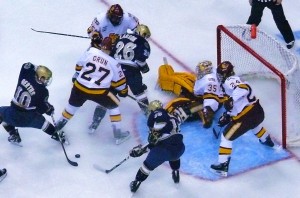
UMD goalie Kenny Reiter had the closest seat in Xcel Center to view Notre Dame's furious closing rally.
By John Gilbert
SAINT PAUL, MINN. — Kenny Reiter regained his lost touch in the third period of Thursday afternoon’s first NCAA Frozen Four semifinal, as Minnesota-Duluth struck for three power-play goals to propel the Bulldogs to a 4-3 victory over Notre Dame and a berth in Saturday night’s NCAA championship game.
The victory sends the Bulldogs (25-10-6) into Saturday’s 6 p.m. final against Michigan (29-10-4), which surprised top-seeded North Dakota 2-0 in the second game of a semifinal day that drew 19,139 to Saint Paul’s Xcel Energy Center. While Michigan will be seeking its record 10th NCAA crown, UMD will be seeking its first title, in only its second title game. The only previous UMD final was in 1984 at Lake Placid, where a 5-4 loss to Bowling Green in four overtimes still stings veteran Duluth fans.
“It’s great to be in position to win the championship — something that’s never been done,” said Jack Connolly, whose second-period goal stood up as the game-winner. “Our power play has been huge for us all year, and fortunately we were able to come through on it tonight.”
Notre Dame (25-14-5) gave UMD all it could handle, grabbing early leads of 1-0 and 2-1, and, after failing to subdue UMD’s power play through two periods, the Fighting Irish rallied from a 4-2 deficit by outshooting the Bulldogs 15-2 to make it a pressure-filled third period.
Freshman J.T. Brown, and juniors Mike Connolly and Jack Connolly scored power-play goals for UMD, and Kyle Schmidt got the lone equal-strength tally. “Our power play has been great all year,” said Fontaine, who assisted on all three power-play goals with clever passes, while freshman defenseman Justin Faulk also had three assists, all in the opening period.
UMD’s penalty killers were just as effective, holding Notre Dame scoreless on five power plays, and limiting the Irish to only two shots on those five opportunities. The Irish penalty killers did sting UMD’s power play for Calle Ridderwall’s shorthanded goal early in the third period to close the gap to 4-3 and leave 18 dramatic minutes before the Bulldogs could claim the victory.
“Obviously, it was a game dictated by one thing — special teams,” said Notre Dame coach Jeff Jackson. “They have an exceptional power play, and we couldn’t generate any offense on our power play.”
The Fighting Irish generated plenty of offense at the outset, although at a point in the tournament where great goaltending usually makes the difference, this one started off as a nightmare for both Reiter and Notre Dame’s Mike Johnson. UMD coach Scott Sandelin attributed it to nerves. “If you don’t have nerves in a game like this, you’re not human,” said Sandelin.
But this game raised the question of whether any shots might strike a goaltender. Notre Dame struck first, when Jack Costello gathered up the puck at center ice and rushed up the right side, shooting from the top of the right circle to beat Reiter on the first shot of the game at 0:49. UMD countered promptly enough, aided by its first power play. Fontaine kept the puck in at the left boards and fed center point, where
Faulk relayed a neat pass to Brown in the left circle. Brown either misfired on his shot or tried to pass to a teammate crossing in front of the goal, but in either case, the off-speed shot resulted in UMD’s first shot of the game, and went through Johnson’s legs at 3:04.
“It was a crazy start,” said Jackson, referring to five first-period goals. Notre Dame regained the lead at 2-1 at 9:46, when T.J. Tynan was wide to the right of the UMD goal where the rebound from Nick Larson’s long shot was headed. Despite almost no angle, Tynan got his shot past Reiter for a lead that lasted barely a minute.
Kyle Schmidt tied it 2-2 for UMD when he caught a hard, diagonal pass rushing up the left side. He veered toward the net and lifted his shot in, short side, at 10:52. UMD got another power play and took its first lead at 13:31 of the first period when Faulk passed in from center point to Fontaine, who immediately passed from the left circle to the slot and Mike Connolly quickly snapped a shot inside the left post. Despite being outshot 15-11 by the Irish, UMD led 3-2.
Faulk, who is from South St. Paul, now has 8 goals and 25 assists as the triggerman on the power play. “It was amazing be able to play here, in front of my friends and family,” said the freshman defenseman.
Faulk’s play was something Jackson admired. “Our special teams had been one of our staples, but it’s been disappointing this season,” said the Irish coach. “We don’t have a quarterback on the point like Faulk is.”
The Bulldogs took apparent command with a dominant second period, as the power play worked its magic again. This time Fontaine circled out to the top of the slot and passed in deep on the left side of the net to Brown, who quickly relayed a pass through a defenseman and across the goal-mouth to where Jack Connolly one-timed a shot into the net before Johnson could adjust. That goal came at 5:51, and the 4-2 margin grew in significance as the minutes passed.
When UMD got another power play early in the third, it was a chance to put the game away. Instead, it was the Irish — skating six freshman forwards and three more freshmen on defense — who clicked. Calle Ridderwall broke up the right side on what looked innocent enough, until he cut toward the slot and pulled up to fire a 40-foot missile that sailed past Reuter and cut the lead to 4-3 at 2:05.
The shorthanded goal helped the Irish respond to coach Jackson’s strong words from the second intermission, and they dominated the third period, while UMD seemed willing to try to sit on the one-goal lead. “They outshot us and outhustled us in the third period,:” said Faulk. “But we got the puck out of our end when we needed to.”
Jackson pulled Johnson for six attackers near the end, but Reiter had found his rhythm and stopped everything, while his scrambling defense held on to the final buzzer.
“We weathered the storm at the end,” said Sandelin. “When our backs are to the wall, we battle back. Sometimes I think we’re better when our backs are to the wall.”
In the second semifinal, Michigan’s quickness seemed to offset North Dakota’s explosive offense, which had established an 11-game winning streak and 15-game unbeaten finish. The Fighting Sioux had romped to the Midwest Region title by blitzing RPI 6-0 and Denver 6-1, but couldn’t get anything past Shawn Henwick — a senior who had been an uncomplaining third-string goalie for three years. Henwick stopped all 40 North Dakota shots, and the Wolverines gained the game-winning goal when Ben Winnett scored only his fourth goal of the season at 13:26 of the first period.
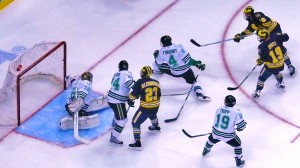
Michigan's Ben Winnett fired past Aaron Dell's glove for the 1-0 lead that stood up against North Dakota.
Winnett converted a rebound off the right pipe after Jon Merrill’s left point shot struck iron. Thereafter, it was a test of Michigan’s ability to use its size and quickness to harness North Dakota’s firepower, and Henwick coming through to stop everything that got through.
The Sioux outshot Michigan 40-19, including 11-3 in the second period and 15-6 in the third. But the good scoring chances could be counted on one hand as Michigan prevented North Dakota’s usual penetration to the net, and the Wolverines 19th shot came from Scooter Vaughan, into an empty net with 36 seconds remaining.
“They’re a better team,” said Berenson. “No way we can match up. They are as good as it gets. But the best team doesn’t always win. In one game, anything can happen.”
North Dakota coach Dave Hakstol saw his team’s 32-9-3 season and a closing 15-game unbeaten streak come to a sudden end. “I didn’t think it was going to end,” he said. “I don’t think anybody in our locker room considered the chance we’d lose. I’m proud of the standards our leaders set — it was not an option in any one person’s mind that we’d lose. There was no frustration in our game. We laid it on the line till the end of the game.”


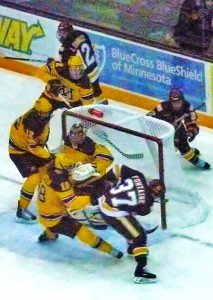
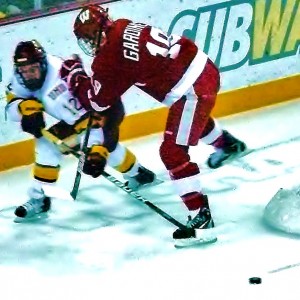
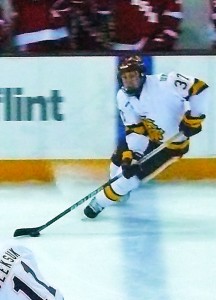
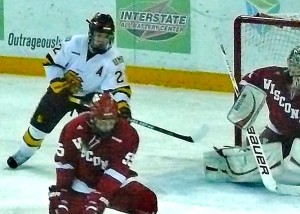
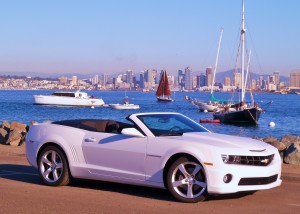
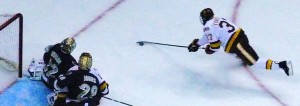
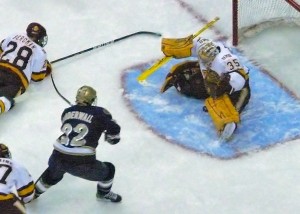
 John Gilbert is a lifetime Minnesotan and career journalist, specializing in cars and sports during and since spending 30 years at the Minneapolis Tribune, now the Star Tribune. More recently, he has continued translating the high-tech world of autos and sharing his passionate insights as a freelance writer/photographer/broadcaster. A member of the prestigious North American Car and Truck of the Year jury since 1993. John can be heard Monday-Friday from 9-11am on 610 KDAL(www.kdal610.com) on the "John Gilbert Show," and writes a column in the Duluth Reader.
John Gilbert is a lifetime Minnesotan and career journalist, specializing in cars and sports during and since spending 30 years at the Minneapolis Tribune, now the Star Tribune. More recently, he has continued translating the high-tech world of autos and sharing his passionate insights as a freelance writer/photographer/broadcaster. A member of the prestigious North American Car and Truck of the Year jury since 1993. John can be heard Monday-Friday from 9-11am on 610 KDAL(www.kdal610.com) on the "John Gilbert Show," and writes a column in the Duluth Reader.